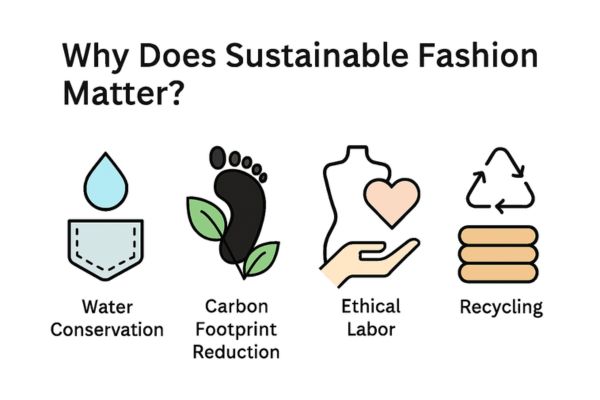What Does Sustainable Fashion Mean?
Sustainable fashion means creating clothing, shoes, and accessories with respect for the planet and the people who produce them. At its core, it’s about designing and consuming fashion in ways that minimize harm to the environment while ensuring fair labor practices and long-term value for consumers. Unlike fast fashion, which prioritizes mass production and low cost, sustainable fashion promotes durability, transparency, and fairness at every stage—starting from material sourcing to garment disposal.
This movement asks important questions: How were these clothes made? Who made them? Were natural resources used responsibly? Understanding these core ideas helps consumers make informed choices and reduce the negative impact of fashion on the world.
Sustainable Fashion: Definition & Values
![Sustainable Fashion: What Does Sustainable Fashion Mean? [2025 Guide]](https://sustainthestyle.com/wp-content/uploads/2025/10/Untitled-design-31.jpg)
Core Values of Sustainable Fashion:
- Efficient use of natural resources: Fashion should maximize the intelligent use of water, energy, and land throughout a garment’s lifecycle.
- Eco-friendly production: Avoiding toxic chemicals, pesticides, fertilizers, and synthetic dyes helps protect soil, air, and water systems.
- Ethical labor practices: Garment workers deserve safe workplaces, fair wages, and respect for their human rights.
- Durability and longevity: Clothes designed to last reduce waste and lower the burden on overflowing landfills.
This definition covers not just the environmental angle but also the human and ethical dimensions, making sustainability a three-pillar concept: planet, people, and product.
Types of Sustainable Fashion Practices
![Sustainable Fashion: What Does Sustainable Fashion Mean? [2025 Guide]](https://sustainthestyle.com/wp-content/uploads/2025/10/Untitled-design-36-1024x576.jpg)
Ethical & Fair Trade
Ethical fashion emphasizes respect for workers, animals, and communities. Brands that adopt ethical practices ensure their workers are paid fairly, provided safe working conditions, and free from exploitation. Fair trade certifications help verify that wages and practices meet responsible standards.
Slow & Circular Fashion
Slow fashion is the countermeasure to fast fashion’s trend-driven model. It promotes timeless designs, better quality garments, and mindful consumption. Instead of buying 10 cheaply made t-shirts, a consumer might invest in 2 high-quality, versatile pieces that last years.
Circular fashion pushes this further by designing items for reuse, repair, and recycling. Clothing is seen not as disposable, but as part of a cycle where materials re-enter the production stream, keeping waste out of landfills. Upcycling and resale platforms also fall under this practice.
Eco-Friendly Materials
The choice of fabric significantly impacts sustainability. Organic cotton, hemp, linen, and bamboo require fewer chemicals and resources, while recycled polyester or nylon give a second life to plastic waste. Non-toxic natural dyes and renewable energy in production further cut down the industry’s greenhouse gas emissions.
Brands like Patagonia and People Tree champion these approaches, setting examples for mainstream fashion to follow.
Why Does Sustainable Fashion Matter?

The fashion industry is one of the top global polluting industries, contributing to water pollution, resource depletion, and 8-10% of global carbon emissions. By prioritizing sustainable practices, the impacts can be drastically reduced.
- Conserving natural resources: Reducing water usage and chemical runoff safeguards ecosystems.
- Protecting workers’ rights: Ethical fashion reduces exploitation in garment factories, especially in developing nations.
- Reducing carbon footprint: Using renewable energy, durable materials, and circular models reduces carbon emissions across the supply chain.
- Empowering consumers: Choosing sustainable fashion allows individuals to align their style with their values—quality clothing that respects both nature and people.
Moreover, sustainability drives innovation. From lab-grown leather to AI-powered textile recycling, the fashion world is evolving toward greener solutions.
How Consumers Can Support Sustainable Fashion
Small steps by shoppers make a big difference.
- Buy less, but better—focus on timeless, versatile pieces.
- Check labels for organic, recycled, or fair-trade certifications.
- Support brands with transparent supply chains.
- Repair, reuse, or donate clothes instead of discarding them.
- Explore local thrift stores, vintage shops, or swap communities.
Each purchase sends a signal to brands about consumer priorities. As demand for sustainable fashion grows, more companies invest in eco-friendly innovation.
Learn more about eco-friendly brands at SustainTheStyle.com.
See blog posts about upcycling ideas and slow fashion tips.
Explore our clothing guides focused on ethical manufacturers.
Green Strategy: Sustainable Fashion Definition
Sustainable fashion is more than a passing trend—it’s a movement toward a fairer and greener world. By choosing timeless, eco-friendly pieces and supporting brands that practice transparency and ethics, we not only express our style but also our values. Every conscious choice, whether it’s upcycling, buying secondhand, or supporting ethical labels, helps shape a future where style and sustainability walk hand in hand. Explore our guides at SustainTheStyle.com to take the next step toward building a wardrobe that’s kind to both people and the planet.

